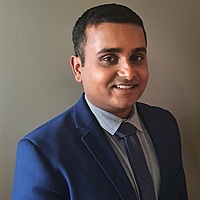The ASX medtech innovator positioned for growth
CurveBeam AI (CurveBeam) (ASX: CVB) listed on the ASX in August 2023 during a challenging period when the IPO market was firmly shut, start-ups globally had seen valuations crunched and healthcare was hard hit. CurveBeam was not immune to these market conditions, seeing its share price fall from A$0.48 per share down to lows of A$0.094.
However, CurveBeam is not your average ASX-listed medical device company. Its products are clinically validated, supported by the publication of dozens of studies and has been adopted by marquee clinical institutions in the US such as the Mayo Clinic, Massachusetts General Hospital, and the Hospital for Special Surgery. Additionally, its lead product, HiRise, is covered by reimbursement from payors in most major markets including the US with customers having already demonstrated successful reimbursement. CurveBeam has also secured a partnership and co-marketing deal for the US and Australian markets with the foot and ankle (F&A) division of the largest orthopaedics medical device company in the world, Stryker, and reported ten signed purchase orders (POs) worth A$5m in revenue in its latest quarterly up 150% on the prior corresponding period. With validation nearing for integration into Stryker’s Mako robotic system, the company could be on the verge of a major sales inflection point.
With all these positives, one may assume that CurveBeam must trade at a significant premium to its listed peers. It does not. With a market cap of just ~A$40m, CurveBeam trades at a significant discount. This valuation gap appears disconnected from the company’s robust fundamentals, including its market presence, clinical validation, and accelerating sales growth. As adoption expands, we believe the gap will narrow, offering substantial upside potential.
Investing at the Value Inflection Point
The two companies that merged to form CurveBeam AI (StraxCorp Pty. Ltd. & CurveBeam LLC) operated independently for over a decade. Their merger was completed in 2022, listing on the ASX in August 2023. At KP Rx we focus on identifying and investing only at key inflection points – moments when we believe substantial value creation is imminent, thereby maximising potential returns for our investors.
We acquired our first major position in CurveBeam in August 2024. Hashan De Silva, KP Rx’s founder and Managing Partner, is also currently a Non-Executive Director on the Board of the company. We believe that at the current share price, CurveBeam represents an upside potential of ~3-4x simply for it to trade in line with its listed peers. This upside does not account for any of the meaningful catalysts detailed in this report, including strong growth potential in a market larger than A$10 billion. With these factors in play, we see substantial value in CurveBeam.
Introducing CurveBeam AI
CurveBeam AI is a medical device company on the cutting edge of orthopaedic imaging with its HiRise weight-bearing CT (WBCT) system. The device addresses significant clinical and operational needs in orthopaedic practices by allowing in-clinic, bilateral weight-bearing imaging – an essential advantage over traditional CT scans. Partnered with Stryker (F&A) in the US and Australian market, the world's largest orthopaedic medical device company, CurveBeam is well-positioned to capitalise on the growing demand for advanced diagnostic solutions in orthopaedics. With traction in key markets across North and South America, Europe, Asia, and Australia, CurveBeam represents a compelling growth opportunity backed by a proven product and the future launch of AI-based modules.
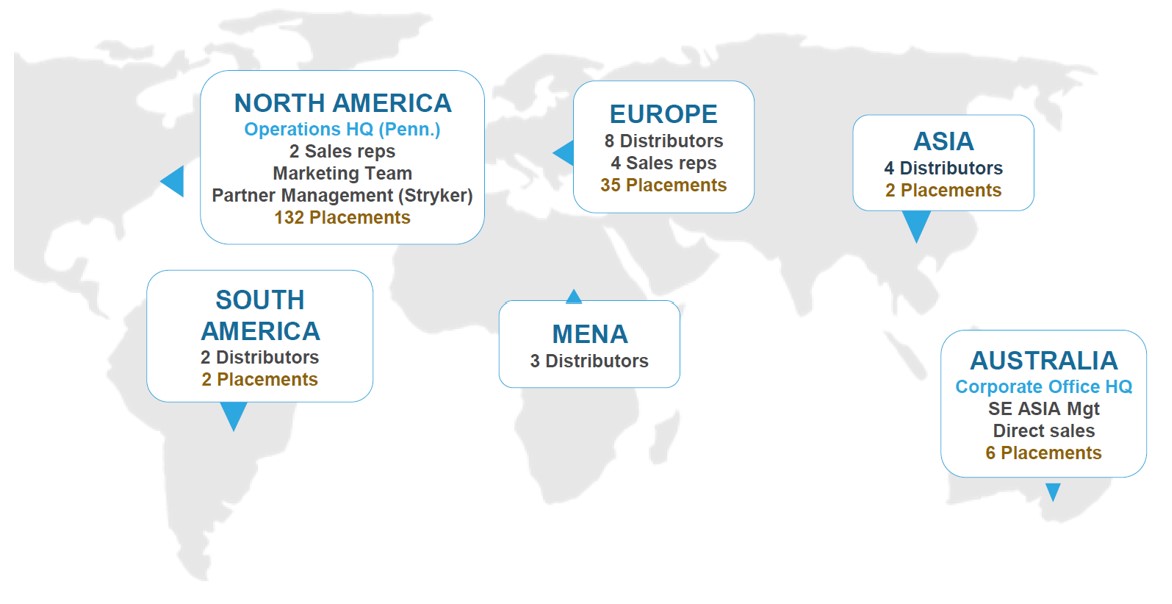
CurveBeam’s flagship product, the HiRise (see here), is the first and only WBCT device to offer bilateral imaging of lower extremities under weight-bearing conditions, which is critical for evaluating knee, hip, foot, and ankle joint alignment and pathology. Traditional supine CT scans are inadequate for accurate orthopaedic diagnosis as they fail to replicate the joint’s physiological alignment. HiRise enables imaging in a standing position, which improves surgical planning and patient outcomes.
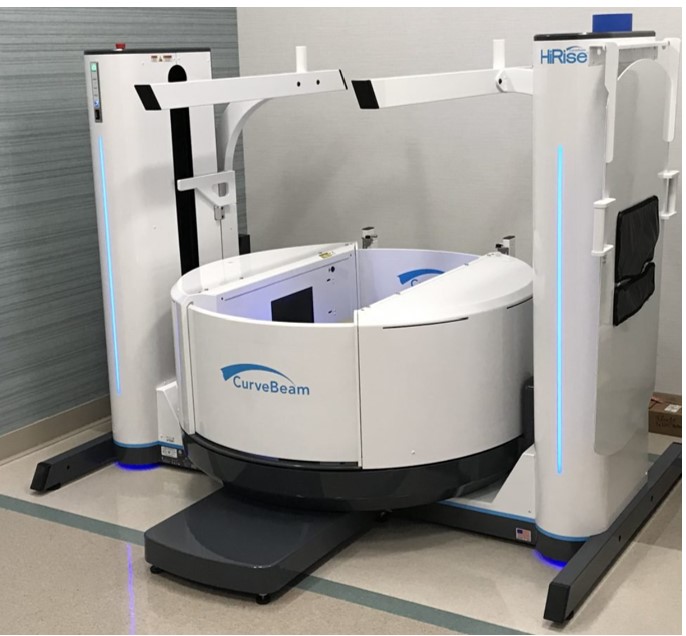
The compact design and high throughput (under one minute per scan for F&A) makes the HiRise suitable for use in busy orthopaedic clinics. The device features an intuitive interface, making it simple to integrate within existing clinical workflows. We recommend investors have a look at CurveBeam’s media page (see here) where there are dozens of customer testimonials, medical conference presentations, publications etc.
Onto the HiRise, CurveBeam is developing numerous AI diagnostic modules. The most advanced is a bone mineral density (BMD) module for the diagnosis of osteoporosis to aid in presurgical planning for knee and hip replacements. This is the part of the business that is most exciting to us and we discuss in more detail below.
The market for HiRise device sales can be broken down into three segments.
- Ambulatory Surgical Centres (ASCs): These are groups of orthopaedic surgeons that have set up independent outpatient centres to perform uncomplex elective procedures such as joint replacements. The number of these clinics have exploded over the last 10 years as more and more procedures have moved out of large hospitals into these ‘day hospital’ settings.
- Imaging Chains: Outpatient chains that provide x-ray, CT, ultrasound and MRI services.
- Hospitals.
All three segments in the US are about the same size at ~A$3.5 billion. ASCs are the primary target for both CurveBeam and Stryker however CurveBeam has sold devices into many hospitals in the US, Europe and Australia.
Significant Benefits for Patients and ASCs
To assess the market potential of the HiRise, we assess the value it delivers to its two key stakeholders, patients and ASCs. Obtaining a pre-operative CT scan today is a major burden in time and workflow (pain point) for patients and surgical practices, which the HiRise can completely alleviates.
Benefits for Patients:
- Enhanced Diagnostic Accuracy: By imaging patients in weight-bearing positions, HiRise allows for a true-to-life representation of joint conditions, especially in hip, knee and ankle pathologies where traditional imaging often misses critical details.

The figure above are two CT scans of the same ankle. The left side image is taken when the patient is supine (not under weight) by a standard multidetector CT (MDCT) and the right is taken using a CurveBeam device with the patient standing up. The left image shows a healthy ankle joint with no impingements and normal joint space. However, when the patient is weight bearing, you can see the cause of the patient’s pain. As you can see from the above images, the angles where the bones sit in relation to other bones is completely different when the patient is weight bearing. This provides for more accurate positioning for an implant.
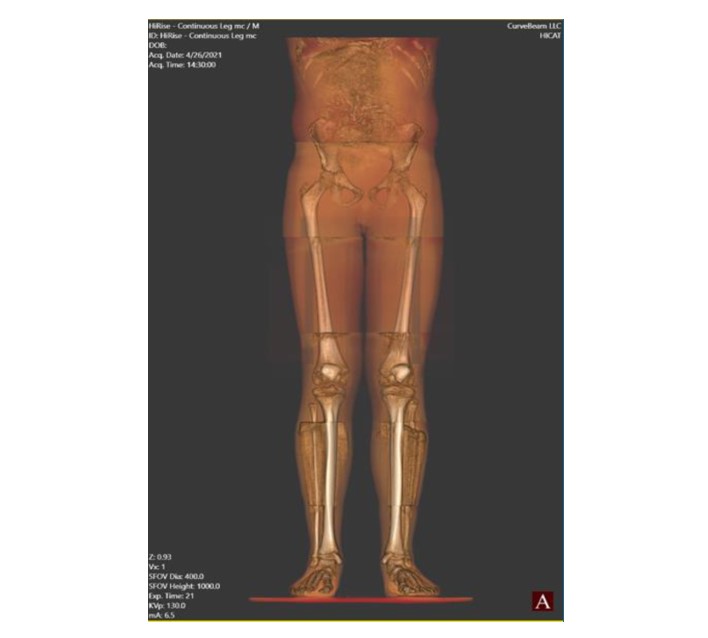
The orthopaedics field has evolved over the last decade, with alignment emerging as a critical factor for implant placement, particularly in the lower limbs. For example, the angle at which a knee implant is placed affects not only the adjacent joints on the same leg, but also the joints on the opposite leg. Proper alignment of the prosthesis must account for the patient’s entire biomechanical structure to ensure optimal outcomes. Focusing solely on the affected joint, without considering its relationship to the rest of the body, risks suboptimal results. The HiRise is the first and only device capable of providing surgeons with this bilateral weight bearing data.
Another major trend in orthopaedics is the growing adoption of patient specific implants (PSIs). These are custom designed implants tailored to the patient’s unique anatomy and injury. The development of PSIs requires highly accurate imaging data to ensure proper design and fit. We believe that the HiRise provides the most diagnostically precise data for PSI, giving it a significant advantage in a rapidly expanding market. CurveBeam has already established partnerships with leading PSI companies such as Exact-Tech, Conformis, and Paragon 28 etc. While we will not delve further into this topic in this report, we emphasise that the increasing demand for PSIs represents an important and growing trend in the orthopaedic industry and a further growth opportunity for CurveBeam.
- Reduced Costs and Convenience: With a HiRise device available at point of care, patients can complete both the surgeon consultation and imaging in a single visit, improving practice workflow, saving significant time and cost. Traditionally, obtaining a CT image requires a referral to a third-party imaging centre, which often imposes out-of-pocket costs – frequently exceeding US$200.
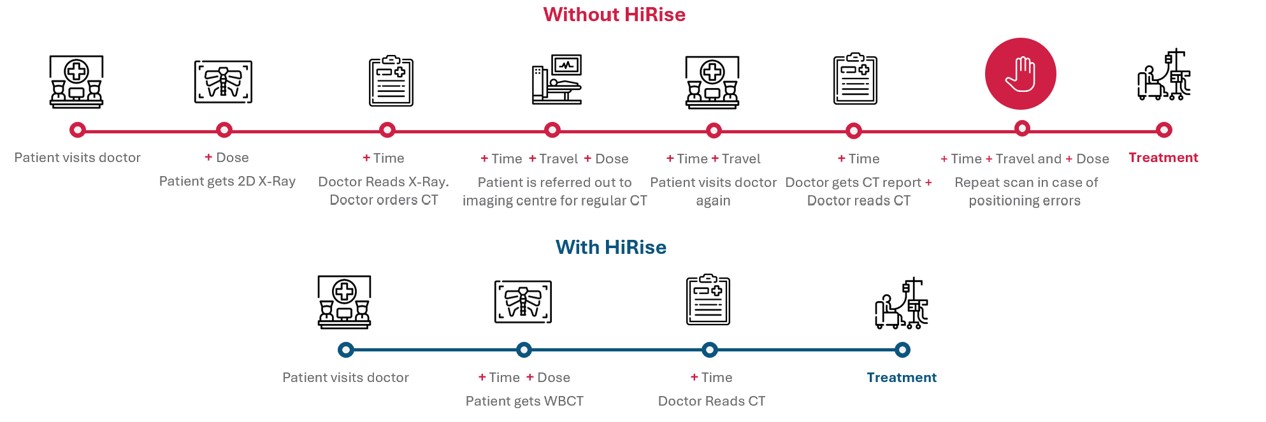
The figure above illustrates the typical patient journey when visiting an orthopaedic surgeon in the US. Nearly all clinics are equipped with an X-ray machine, and generally all patients will receive an X-ray at their first visit. If the surgeon determines that a CT scan is necessary after reviewing the X-ray, the patient is typically referred to an external imaging centre or hospital. This requires the patient to find an imaging centre that is ‘in network’ with their insurer, schedule another appointment, make an additional trip, and incur further time and expense. Even if the CT scan is covered by insurance, patients often face out-of-pocket costs, adding to the financial burden. Finally, the patient will usually need to return to the surgeon again to discuss their recommended treatment plan. If there are any problems with the CT scan, such as poor image quality, the process must be repeated, compounding the inconvenience and cost for the patient.
After the referral to an imaging centre is made, the clinic can lose visibility into the patient’s scheduling, creating potential delays and inefficiencies. On occasion the patient may need to schedule a CT scan for weeks or even months later, prolonging the diagnostic timeline. Additionally, patients may be informed of insurance denial or significant out-of-pocket costs at the time of booking or before the scan, leading to cancellations. Even if the CT scan is completed, the patient must schedule another visit with the surgeon to review the results and discuss the recommended treatment plan, adding further time and inconvenience to their care journey.
Having a HiRise available at point of care greatly streamlines this entire process.
- Reduced radiation exposure: HiRise offers a significant reduction in radiation exposure – up to 30% less compared to conventional CT scans covering up to the hip. Depending on the part of the body being imaged, the radiation exposure can be negligible. For instance, imaging both feet with the HiRise results in a dose of ~6 micro-Sieverts (µSv), which is even lower than the 8 µSv of background radiation an individual is exposed to daily at sea level (see here).
- Improved Outcomes: Research has shown that using WBCT may be a superior option for joint replacement surgeries, with evidence supporting its effectiveness, particularly in the foot and ankle subspeciality (see here). WBCT is also showing promise in applications involving patient-specific implants (PSIs) though additional studies are required to establish its superiority over traditional supine CT. The HiRise is the only device capable of generating true 3D images with the joint in its natural physiological setting (i.e., under weight) while also accounting for total bilateral alignment, providing unmatched accuracy in diagnostic and surgical planning.
Benefits for Ambulatory Surgery Centres (ASCs):
- In house imaging. Referring patients to an external imaging centre can risk losing them to follow-up and creates significant workflow and scheduling inefficiencies for surgical practices. External imaging centres also leave practices with limited control over scheduling, delaying surgeries until the scans are completed. By keeping imaging in-house with the HiRise, practices can streamline the patient care continuum, enabling more efficient scheduling and coordination. Our conversations with clinics showed improved patient satisfaction and significantly more streamlined diagnostic workflows with the HiRise in place. COVID has also helped to accelerate the internalisation of imaging. During COVID, total joint replacement surgery was deemed elective, and imaging was refused/delayed.
- New Revenue Stream: Bringing CT imaging in-house, allows ASCs to retain the CT imaging revenue, which was previously referred out and billed by the radiologist. Given the high reimbursement rates, ASCs can break even with just 2-3 scans per day (outlined further below).
The integration with Mako surgical robotic system (discussed in more detail below) turbocharges the ROI calculation for ASCs. For example, in a recent trip to Omaha, one foot and ankle surgeon described how just one knee surgeon at his centre is performing ~800 Mako-assisted knee replacements annually. Each of these surgeries requires two CT scans – one pre-operative and one post-operative. Using HiRise for these scans could generate roughly US$640,000 annually in imaging revenue for this centre from this one surgeon alone, compared to the device’s price point of US$410,000. This level of financial ROI is unmatched, with a potential payback period of less than a year, making HiRise an economically compelling investment for Mako-enabled practices.
|
Cost of device |
US$410,000 |
|||
|
Interest rate |
7% |
|||
|
Months |
60 |
|||
|
Monthly payment |
$8,118.49 |
|||
|
Service cost monthly |
$2,391.67 |
|||
|
Today |
At Capacity |
|||
|
Images per day |
3 |
Images per day |
32 |
|
|
Average Reimbursement |
$200 |
Average Reimbursement |
$200 |
|
|
Out of pocket |
$200 |
Out of pocket |
$200 |
|
|
Revenue per day |
$1,200 |
Revenue per day |
$12,800 |
|
|
Revenue per month |
$26,000 |
Revenue per month |
$277,333 |
|
|
Profit |
$15,489.84 |
Profit |
$266,823.18 |
|
|
Payback period (yrs) |
1.3 |
Payback period (yrs) |
0.1 |
The above illustrates the ROI calculations for practices. Our feedback from US surgeons indicates that average reimbursement is ~US$200 per scan with Medicare being the lowest at US$140 and private insurers significantly higher. Depending on the location, centres also charge an out-of-pocket payment which we understand is about US$200. Assuming a 7% interest rate and 5-year term, just 3 scans a day will generate US$26,000 in revenue or ~US$15,000 in profit per month. If we assume that capacity for the HiRise is 4 scans an hour (~15mins to get the patients in, measured, imaged etc) and an 8-hour workday, a device at capacity would be able to do 32 images a day. This would generate an ASC US$266,000 in monthly profit.
The other potential costs not captured in this model is the cost of room setup and any new staff required to run the HiRise. As the HiRise has some self-shielding, in some cases the room shielding/setup requirements are not significantly more than what is already in place for the centre’s X-ray room. In addition, in most US states, the HiRise can be operated by an X-ray technician who generally is already employed by the centre. As volumes increase on the HiRise, a new hire may be required, however a HiRise doing 3 scans per day allows for a hire at a monthly salary of US$10,000 and still generates ~US$5,500 of monthly profit.
To put these numbers into context, the example used above of the knee surgeon from Omaha who conducts 800 Mako knee surgeries a year, this one surgeon would require ~6-7 images a day on the HiRise just for these Mako knee patients alone. Most group surgeon clinics have ~10+ surgeons. We spoke with a foot and ankle surgeon in Portland, Oregon who mentioned that he is no longer able to get same day appointments for their HiRise due to the demand by the other surgeons, notably hand surgeons at his clinic.
- Operational Efficiency: With scan times faster or on par with X-rays, but offering much higher diagnostic yield, HiRise enables practices to manage patient flow more effectively.
We have spoken with surgeons who now have instructed their physician assistant (PA) or nursing staff that when a patient presents with certain conditions, they are to get a HiRise scan prior to the first consult. This ensures the surgeon has all the necessary data at the time of the first consult, allowing them to discuss the recommended treatment plan immediately. This reduces the number of appointments from 2 to 1, freeing up more time for surgeons to see new patients and/or perform additional surgeries, directly boosting the surgeons’ and ASCs’ earnings.
As surgeons do not manage patients on an ongoing basis, the lifeblood of their practice is new patients. The efficiency gained through the HiRise can translate into substantial financial benefits for both the surgeon and the clinic. For example, one extra total ankle replacement surgery per month is equivalent to ~US$20,000 to US$50,000 in revenue (see here). We have spoken with several surgeons who have described the meaningful increase in the number of surgeries they can perform due to the improved workflows enabled by the HiRise. While this anecdotal evidence is promising, we would like to see quantitative data generated by the company which would further characterise and validate this efficiency dividend.
- Enhanced Pre-Op Planning with BMD Module: The upcoming BMD module, targeted for release around mid-2025, will enable practices to perform comprehensive bone health assessments, which align with the American Association of Orthopaedic Surgeons (AAOS) guidelines for knee and hip joint replacements. In addition to enhancing clinical decision-making and improving patient outcomes, the BMD module presents an additional revenue opportunity for ASCs, offering high-margin reimbursement potential while streamlining the pre-operative planning process.
Following FDA clearance of the BMD module for the HiRise, orthopaedic surgeons will be able to screen patients for osteoporosis using the same image obtained for preoperative planning. This is designed to sit within their workflow and not slow down the management of the patient.
The AAOS has identified osteoporosis as a National Public Health Priority and has actively lobbied for its recognition by the US government (see here). Diagnosing osteoporosis prior to surgery can significantly influence treatment plans, including the selection of implant type (cemented vs uncemented) and the need for preoperative interventions. Patients with undiagnosed and untreated osteoporosis can experience complications during and after surgery such as periprosthetic fractures and implant failures (see here). Studies show that only ~12-20% of eligible patients are screened for osteoporosis prior to surgery (see here).
For patients diagnosed with severe, untreated osteoporosis, surgeons can apply a ‘modifier’ to their insurance billing to reflect the increased complexity of care. Our research indicates that this modifier, while varying by payer, typically results in a 20% increase in the reimbursement rate.
BMD screening reimbursement is already established in the US under CPT code 77078 with an average reimbursement rate of ~US$140. CurveBeam intends to commercialise this product through a revenue sharing model with the clinic, where the clinic retains US$50 per BMD report generated off the pre-existing CT scan, and CurveBeam collects US$90. For the clinic, this arrangement increases the profitability of their HiRise device. For example, performing just three BMD scans per day could generate an additional ~US$39,000 in annual profit, with no incremental cost to the clinic since the images are already captured during preoperative planning.
In addition to the BMD module, CurveBeam is also developing AI modules to assist surgeons with their preoperative planning. The most advanced module is Autometrics (see here), designed to automatically segment all the bones in the foot and ankle, characterise joint space, calculate all angles. A study published in over 500 patients demonstrated that Autometrics achieves accuracy comparable to a surgeon while completing the task in just 3% of the time (see here). By automating the equivalent of 16 hours of manual work into minutes, Autometrics represents an attractive advancement in surgical efficiency.
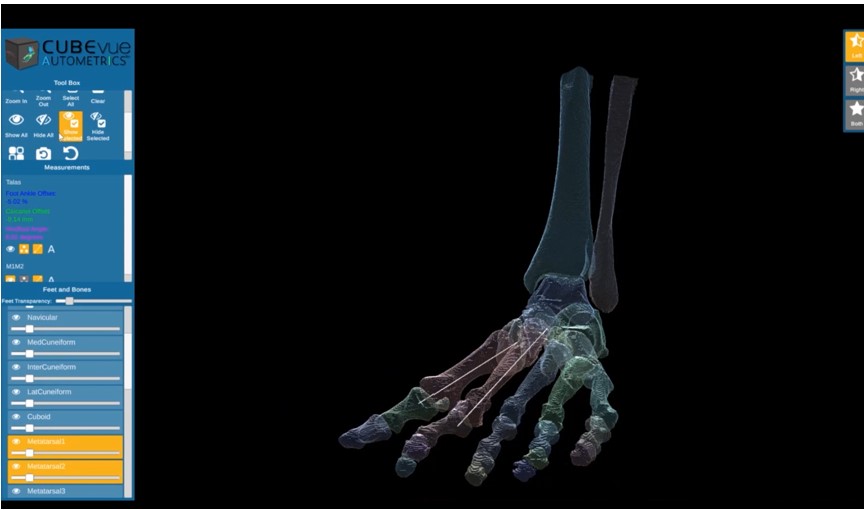
Once FDA cleared, this module will be available for purchase on all HiRise devices. Initially, no reimbursement will be available for this product, therefore pricing will need to reflect this. If CurveBeam prices this module at, for example, US$20,000 per HiRise, this would generate ~US$2m in revenue for every 100 HiRise devices installed, with a gross margin exceeding 95%.
We are extremely excited by the potential of these AI diagnostic modules, with the BMD module in particular, emerging as the key value driver for CurveBeam over the medium term.
Additionally, CurveBeam has developed an innovative diagnostic tool for osteoporosis called the Structural Fragility Score (SFS) which we believe represents the single most exciting IP within CurveBeam to date. While this project is still in its early stages, initial results are promising. In a clinical trial involving over 2,000 women, SFS demonstrated the ability to predict ~70% of fractures, significantly outperforming traditional BMD assessments, which predicted only ~29% (see here).
Stryker Partnership
CurveBeam’s US partnership with Stryker (F&A), the world’s largest orthopaedic medical device company (NYSE: SYK, market cap: ~US$145 billion), is a cornerstone of its US market strategy. Stryker’s extensive reach, established salesforce, and innovative product portfolio provides CurveBeam with unparalleled access to orthopaedic practices across the US, the key growth market.
CurveBeam announced this partnership with Stryker’s Foot and Ankle (F&A) division in September 2022. The F&A division has ~500 sales reps and ~40 regional managers in the US compared with the 2 sales reps CurveBeam has employed. The partnership formally launched in May 2023, offering several compelling benefits for Stryker’s F&A sales reps when selling HiRise:
1. Financing solutions. Multiple financing programs allow a customer to lease a HiRise device from Stryker and pay for it through the purchase of implants, consumables, etc. Flexible financing options offers a powerful tool for Stryker, enabling them to increase their market share while securing contractual commitments from clients for terms of ~5-7 years. We spoke with a centre on the West Coast of the US who were one of the first to purchase a HiRise through this Flex financing. This particular centre increased their payments to Stryker by over 100% annually after purchasing the HiRise. Feedback indicates that the F&A team do not have any other tools or methods to achieve such rapid growth.
2. Prophecy navigation alignment system. This is the marquee product of Stryker’s F&A division. It is a custom surgical cut guide tailored to individual patients undergoing total ankle replacement (see here). Generating these guides requires CT scans, and before the CurveBeam partnership, patients were referred to external imaging centres. After the image is captured, a Stryker rep will then drive to the imaging clinic and pick up a CD with the images, then upload the data into the Stryker portal (we discuss this process in more detail below). With the HiRise, this cumbersome, manual process is eliminated, as the data can be automatically uploaded into the Stryker portal, saving significant time and effort. Importantly, the HiRise also addresses a key barrier to increased adoption of the Prophecy system by simplifying and streamlining the workflow which we previously discussed.
3. HiRise is a point of differentiation. HiRise provides Stryker with a competitive edge that no rival can match. By solving the problem of external CT referrals and creating an attractive revenue stream for surgical centres, HiRise not only supports Stryker’s existing offerings, like Prophecy, but also drives broader adoption of their products.
Observations and Challenges
Prior to investing in CurveBeam, we conducted extensive due diligence, speaking with dozens of U.S. surgeons, Stryker sales reps, and competitors. Our research included a recent trip to the US, where we accompanied Stryker reps across three cities – Portland, Omaha, and Des Moines – as they visited surgeons, hosted meetings etc to gain firsthand insight into the sales process. While these interactions reinforced our confidence in the HiRise, early sales have been slower than anticipated due to several factors:
1. Subspecialty Dynamics in Ambulatory Surgery Centres (ASCs): F&A surgeons are fully bought in. For the F&A surgeons we have spoken with, the benefits of WBCT have now been established as the standard of care and the question of clinical utility no longer exists for them. We sat in various meetings where the F&A surgeons advocated for the purchase of a HiRise to the ASC’s management. However, F&A surgeons typically represent a small portion of the subspecialties at these centres, where hip and knee surgeons usually dominate. To accelerate adoption, CurveBeam must demonstrate HiRise’s value to these larger subspecialties, which we discuss further below.
2. Brand Association with F&A: While CurveBeam has built strong credibility in the F&A space, the company’s brand needs to expand to the broader orthopaedic field. HiRise is capable of imaging all orthopaedic areas except for the shoulder and spine, making it relevant for hand, elbow, hip, and knee subspecialties that are larger subspecialties within orthopaedic practices.
3. Salesforce Familiarity with Capital Equipment: Stryker’s F&A team had no prior experience selling capital equipment, which proved to be more of a hurdle than we expected given the different skillset required. Selling a HiRise involves navigating beyond surgeon buy-in to engage ASC management, a skillset that took time for the team to develop. Additionally, many F&A sales reps were initially unfamiliar with financing options and the value it could deliver for ASCs, delaying adoption efforts.
4. Return on Investment calculation: The number one concern or pushback that ASCs have when considering a HiRise purchase is uncertainty about the ROI. Specifically, they question whether the device can generate sufficient demand from the surgeons to justify the cost. Our research indicates that ASC management teams do not believe that volumes from F&A surgeons alone is enough to support the purchase of a HiRise. While this belief is incorrect, we believe the fastest and most effective way to address this issue is through validation on Stryker’s Mako Surgical System.
Mako Surgical System Integration
Stryker’s Mako Surgical System is a robotic-assisted platform that enables highly precise knee and hip replacements by utilising CT imaging for pre-operative planning. This reliance on detailed CT scans makes CurveBeam’s HiRise an ideal solution. By providing in-clinic, weight-bearing imaging, HiRise eliminates the need for third-party imaging referrals, significantly improving operational efficiency and return on investment (ROI) for orthopaedic practices (as already discussed).
Additionally, the seamless integration of HiRise with Mako simplifies the workflow for surgeons and surgical centres. The requirement for a CT scan for pre-operative planning for the Mako is a key pain point for surgeons. Stryker’s competitors actively market that their robotic surgical systems are CT-free. Johnson & Johnson’s Velys, which uses X-ray data for preoperative planning, highlights CT-free in the first sentence on their homepage as the key differentiator.
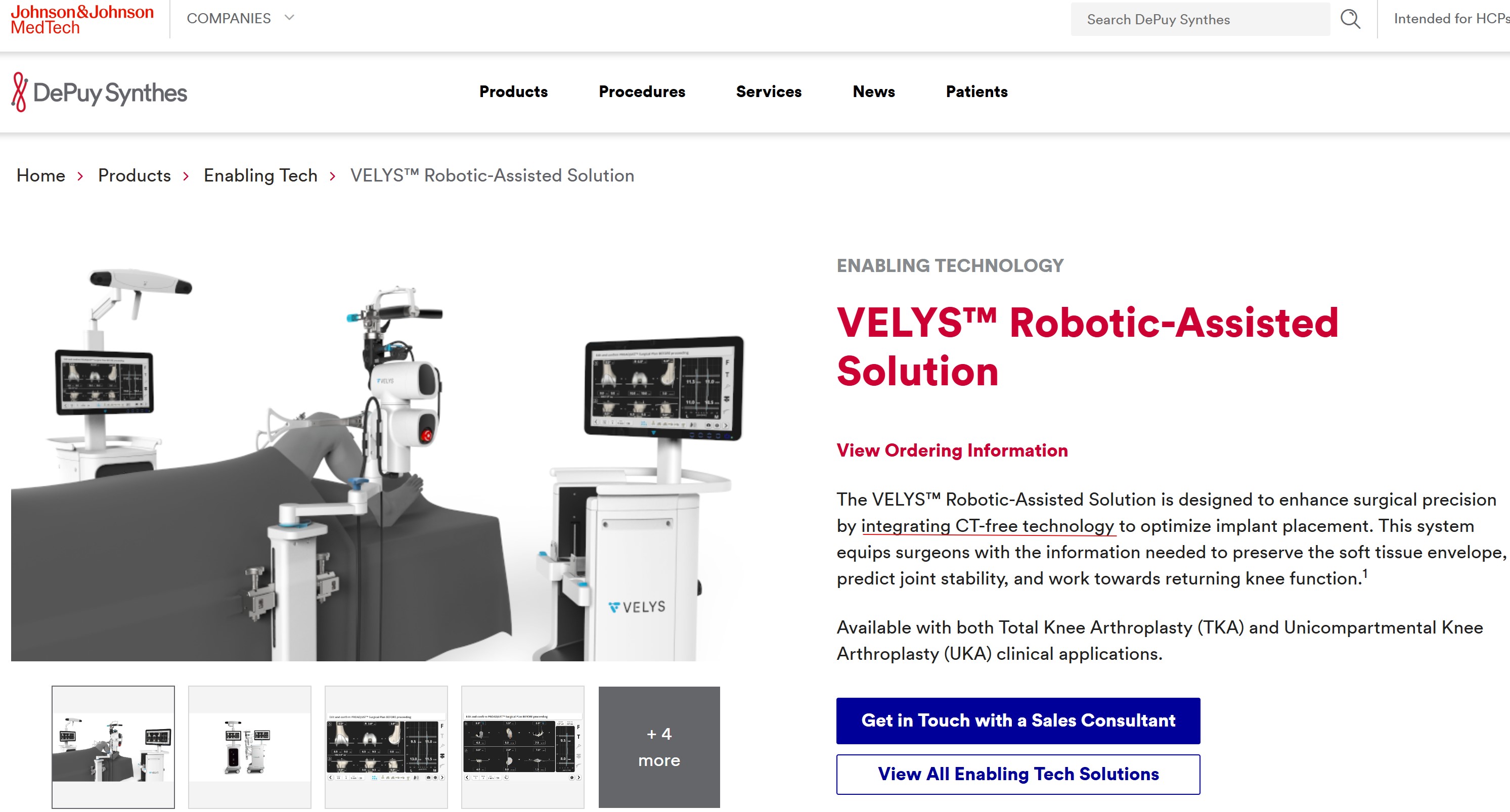
Smith and Nephew recently partnered with JointVue (see here), an ultrasound device for preoperative planning for their Cori Surgical System.
HiRise provides precise bilateral, 3D, weight-bearing images suited for accurate pre-operative planning, which neither X-ray nor ultrasound can do. For ASCs, CT reimbursement is much higher than X-ray or ultrasound and image acquisition time on the HiRise is much quicker than with ultrasound and similar to X-ray. These capabilities on the HiRise significantly enhance Stryker’s competitive advantage by providing accurate 3D imaging compatible with their robotic surgical requirements. This will position HiRise as an indispensable tool for practices utilising Mako.
For Stryker, HiRise offers significant efficiency gains for their salesforce. We have been informed that Stryker’s hip/knee sales reps currently spend on average, two hours per day driving around and collecting CT scan DVDs/CDs from various imaging centres (1 disc per patient) in their territory and manually uploading the images to the Stryker portal for Mako surgeries. This process is not only time-consuming but also highly inefficient. With HiRise, images can be automatically uploaded to the Stryker portal, eliminating the need for manual intervention. This functionality is already targeted for Stryker’s F&A product, the Prophecy surgical cut guides, where automatic uploads save substantial time and effort for the sales team.
Following HiRise validation for the Mako surgical robot, Stryker reps will gain a significant efficiency advantage where a HiRise is placed, saving up to two hours daily that can be redirected toward far more productive activities. Alternatively, Stryker may choose to streamline its field force, improving profitability. The potential for synergy between CurveBeam and Stryker’s Hip and Knee (H&K) division is substantial, and extending the partnership to include this much larger organisation – comprising ~2,500 sales reps – represents a significant growth opportunity for CurveBeam.
What else is left to complete this validation process? CurveBeam announced in late November 2024 (see here) that all data and documentation requested by Stryker will be submitted by early December 2024. As this process does not involve consultation with external regulatory bodies, such as the FDA, we anticipate a swift validation outcome but note this timing is outside of CurveBeam’s control.
With an estimated 2,000 Mako devices installed across the US, this potential market for the HiRise, assuming a one-to-one ratio with Mako installations, represents a ~A$1 billion opportunity. Our research indicates that Stryker sell about 200-300 new Mako devices a year in the US. If the HiRise was to be sold alongside, this would be a A$100-150 million a year opportunity.
As Stryker’s F&A division increasingly promotes the benefits of HiRise’s integration with Mako, we expect adoption rates to accelerate significantly. This mutually beneficial partnership positions CurveBeam to expand its market presence effectively, while also delivering meaningful value to orthopaedic practices and improving patient care outcomes.
Competitors
CurveBeam is in a uniquely advantageous position regarding its branding and recognition in the market. After speaking with dozens of surgeons in the US, none could name a competitor, and many noted that CurveBeam has become synonymous with WBCT. Despite this strong market position, CurveBeam does have one recognised global competitor: the Planmed Verity.
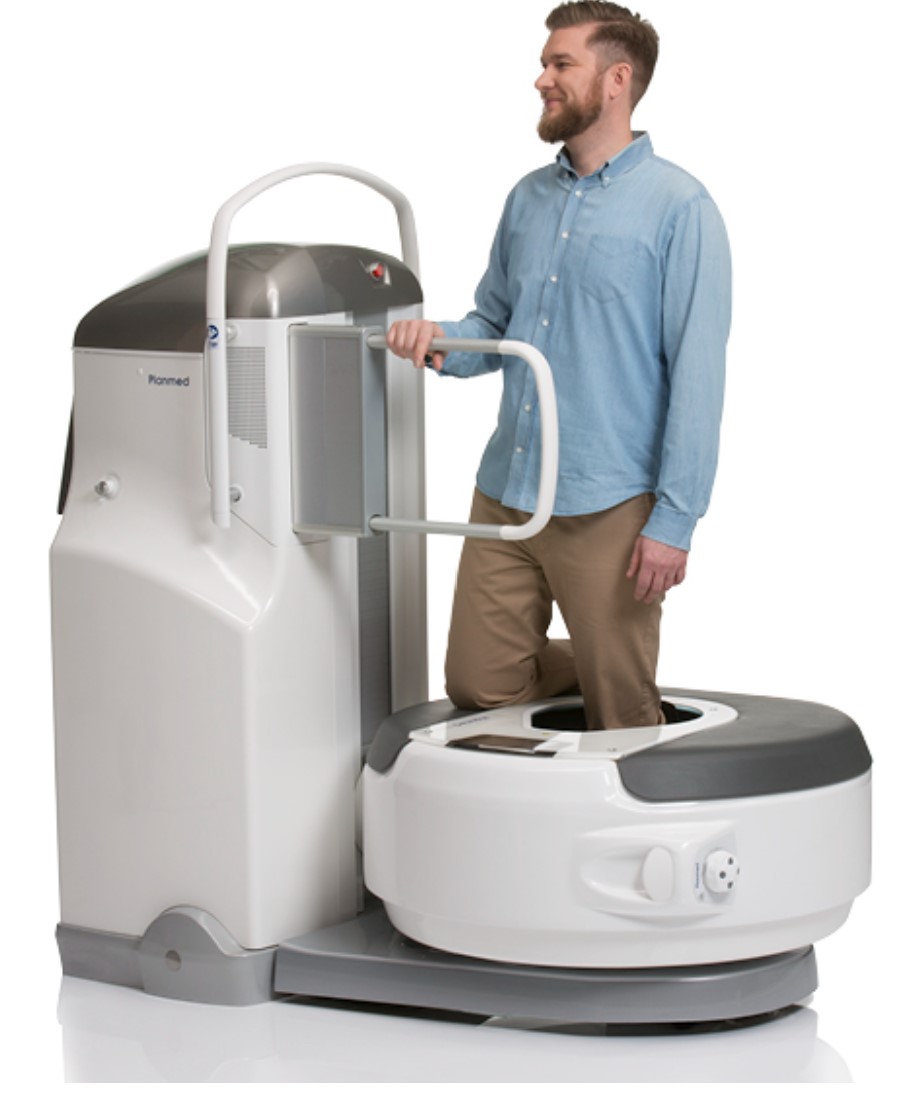
The Planmed Verity is the only other WBCT product available in the market for ankle and knee only (partial foot). However, the Verity has several significant design limitations compared to the HiRise. The Verity can only do 1 leg at a time, requiring the patient to fold the other leg awkwardly onto the device while putting nearly all of their weight on the injured limb. For knee imaging, this setup demands a level of flexibility that many patients may lack, especially those with injuries or limited mobility. Additionally, because the Verity images one leg at a time, it cannot produce ‘true weight bearing’ images or provide any functional alignment data. This is a critical shortcoming, as bilateral alignment is important for surgical planning.
As a result of these deficiencies, the Verity has struggled to gain traction, and we believe has an installed base in the US of less than 10 devices. We do not consider it to be a competitive threat to the HiRise.
Planmed have also been pre-promoting a new version called the XFI (see here) which is yet to receive FDA clearance or CE mark (European approval). The XFI appears to target a different segment of the market and is expected to be offered as a dedicated supine device only at first (then upgrading to weight bearing later), unlike HiRise that can do both supine and standing, and at a different price point to the HiRise. The XFI will also likely require significantly more space, making it less suitable for compact clinical settings. Consequently, we do not view the XFI as a direct threat to the HiRise. Furthermore, CurveBeam is also actively developing the SkyRise (see here), which will compete directly with the XFI in its target market segment, further mitigating any potential competitive risk.
In addition to its superior product design, CurveBeam has a clear advantage in its development of advanced software modules. We are not aware of any BMD, pre-surgical planning, or other software modules under development for Planmed’s existing Verity product for the XFI. CurveBeam’s SaaS offerings, particularly the automated BMD module, creates a strong competitive moat by providing additional clinical utility and recurring revenue streams. Once approved, these modules will further differentiate CurveBeam’s devices and strengthen its leadership position in the bilateral WBCT market.
Revenue Models
- Direct Sales and Partnerships: CurveBeam currently operates through direct sales and through its partnership with Stryker. We estimate average sales price for the HiRise at US$410,000 and targeted gross margins of 50%.
The primary market for HiRise is ~5,800 ASCs in the US. This is complemented by ~5,200 hospitals with orthopaedic capabilities and ~6,000 imaging centres. Together this represents a total addressable market in the US alone of A$10 billion. Beyond the US, Germany represents the next largest market, with an estimated TAM of A$1 billion based on ~2,000 potential placements. CurveBeam also has distributor agreements covering other markets.
- SaaS Modules: CurveBeam’s planned SaaS modules, particularly for AI-based pre-operative planning and BMD assessments, will transition the business towards a recurring revenue model with minimal additional costs. This strategic shift not only aligns with broader healthcare trends but also significantly enhances CurveBeam’s long-term profitability and scalability.
The BMD module already benefits from existing reimbursement in the US for the diagnosis of osteoporosis (average ~US$140 per test). As discussed above, CurveBeam’s plans to implement a revenue-sharing mode, charging practices US$90 per test with the clinics retaining US$50. Assuming 5 BMD tests per day, each HiRise could generate ~A$180k in revenue for CurveBeam at a very high gross margin (95%+). The financial potential of this recurring revenue model becomes increasingly compelling as the installed base grows. An installed base of 1,000 devices – a target we view as highly achievable – could generate almost A$200m in annual revenue from the BMD module alone. CurveBeam is targeting FDA clearance of the BMD module around mid-2025, a milestone that will unlock this significant revenue stream based on HiRise placements over time. In addition to BMD, modules like Autometrics (discussed above) will generate further high margin recurring revenue. These modules reinforce the importance of building out the installed base as the primary short-term focus for CurveBeam.
Valuation and Path to Breakeven
- Valuation: CurveBeam’s current share price of 12.5 cents at the time of writing puts it at a market cap of ~A$48 million (~388m SOI), representing a substantial discount compared to ASX-listed peers. For instance, ImpediMed (IPD) trades at a market cap of ~A$110 million, despite still building reimbursement coverage for its test and suffering from a recent decline in market value. This favourable comparison underscores CurveBeam’s compelling valuation relative to its sector peers, given its favourable reimbursement position, established market presence, clinical validation, and near-term breakeven potential.
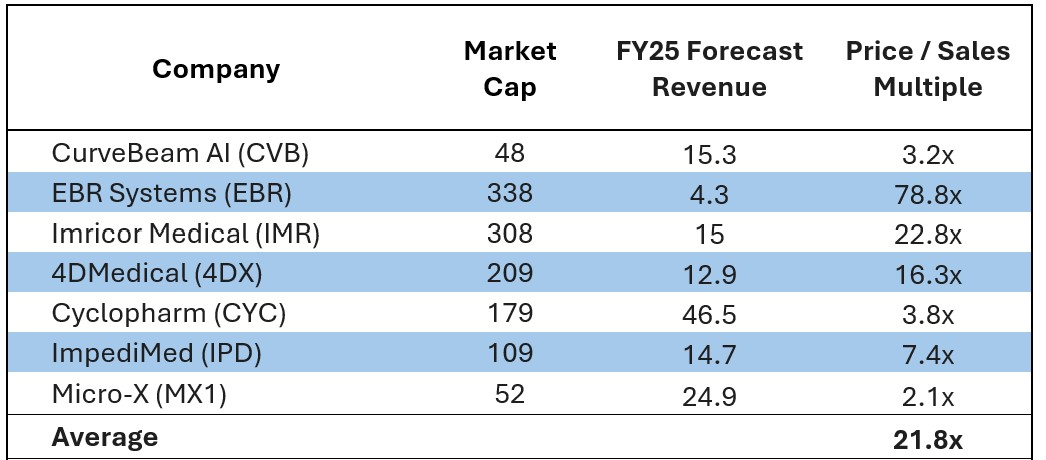
- Breakeven: The company has stated that the annualised cash cost base of the business is ~A$17m. Therefore, with a price of US$410k and assuming a 50% gross margin, the company needs to sell ~17 HiRise devices a quarter to breakeven. Quarterly growth throughout calendar 2024 has been promising with 10 devices sold in Q2 CY24, reinforcing the feasibility of this target. Additionally, we expect the integration with Stryker’s Mako robot to provide a significant boost to sales as HiRise becomes increasingly valuable for orthopaedic practices leveraging robotic surgical solutions.
Risks and Mitigations
- Sales Execution Risk: Initial uptake of HiRise has been slower than expected, largely due to insufficient branding and a lack of salesforce training at Stryker. However, our interactions with Stryker indicate proactiveness to addressing these issues. Enhanced training, better branding, and an emphasis on the financial ROI of HiRise are expected to improve adoption rates.
- Regulatory and Product Development Risk: While HiRise has been approved in most major markets, the BMD module is still in development and subject to FDA clearance. CurveBeam is targeting to mitigate this risk by staging the clearance for the BMD module by aligning development timelines and leveraging extensive MDCT clinical data, which supports the clinical utility and safety of using the BMD module on all MDCT devices first, then expanding to HiRise.
- Execution Risk with SaaS Integration: Transitioning to a SaaS model introduces operational complexity, particularly in training clinics to use and rely on these tools. CurveBeam has proactively managed this by designing user-friendly, in-clinic software that can be integrated seamlessly into existing clinical workflows, minimising disruption.
- Market Liquidity Risk: CurveBeam’s stock has faced liquidity challenges post-IPO, with significant price sensitivity due to limited free float. However, this also presents a potential buying opportunity for investors as liquidity is likely to improve with increased investor interest.
- Market reimbursement: CurveBeam’s reimbursement relies on existing coding, payment and coverage for CT scans on the physician fee schedule. While CT has been well established and has enjoyed long term coverage, changes can occur in payment that could impact ROI based on CT reimbursement. With the BMD module, reimbursement presently only exists in the US. It utilises existing coding, payment and coverage by CMS and private payers. Reimbursement can change with medical policy updates on an annual basis.
Upcoming Catalysts
- Stryker Mako Integration Validation (early CY25): This milestone will provide validation for HiRise’s compatibility with Mako, expanding its value proposition for practices using robotic surgery.
- Expanding the Styker relationship: Both in product and market distribution options.
- Increased Sales through Stryker Partnership: As Mako validation comes online, CurveBeam’s revenue from HiRise placements is projected to increase.
- BMD Module FDA submission (mid-2025): The BMD module represents a significant high margin revenue opportunity with existing US reimbursement codes in place. We expect this to drive recurring revenue and provide significant value to orthopaedic practices.
- International Expansion: With a particular focus on Germany, it is well-positioned for expansion in Europe and other regions with strong orthopaedic demand.
Conclusion
CurveBeam AI’s HiRise bilateral weight-bearing CT system is redefining orthopaedic imaging with its unique capability for in-clinic, load-bearing scans. HiRise offers unparalleled diagnostic capabilities and convenience, significantly improving patient and clinic experiences. The company’s partnership with Stryker’s Foot and Ankle division further strengthens its market position and supports adoption, providing a competitive advantage and substantial growth potential.
With numerous near-term catalysts, including validation for Stryker’s Mako robotic system and FDA approval for the BMD module, CurveBeam is well-positioned for a period of accelerated growth. The company’s scalable SaaS model, significant market opportunity (~A$10 billion TAM), and robust clinical validation highlights its potential in the orthopaedic imaging space.
Despite these strengths, CurveBeam continues to trade at a significant discount to listed peers. As adoption accelerates, sales grow, and upcoming milestones are achieved, we believe there is substantial scope for this valuation gap to narrow. We see 2025 as a transformational year for CurveBeam AI, with material value creation expected as the company executes on its strategy and delivers tangible results.
5 topics
5 stocks mentioned
